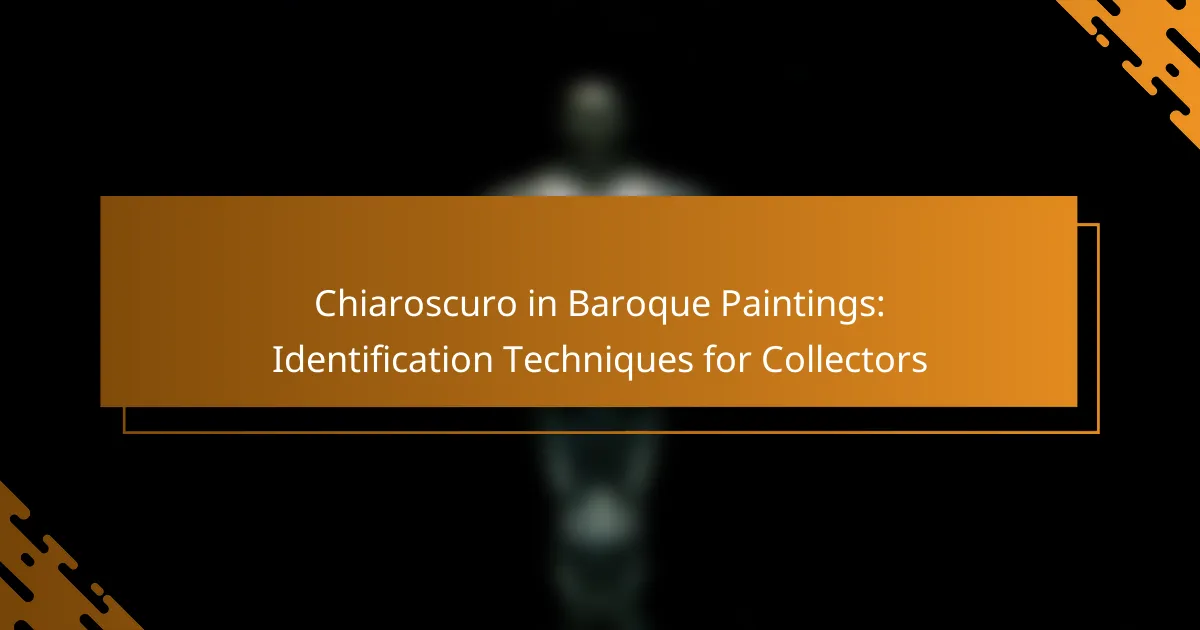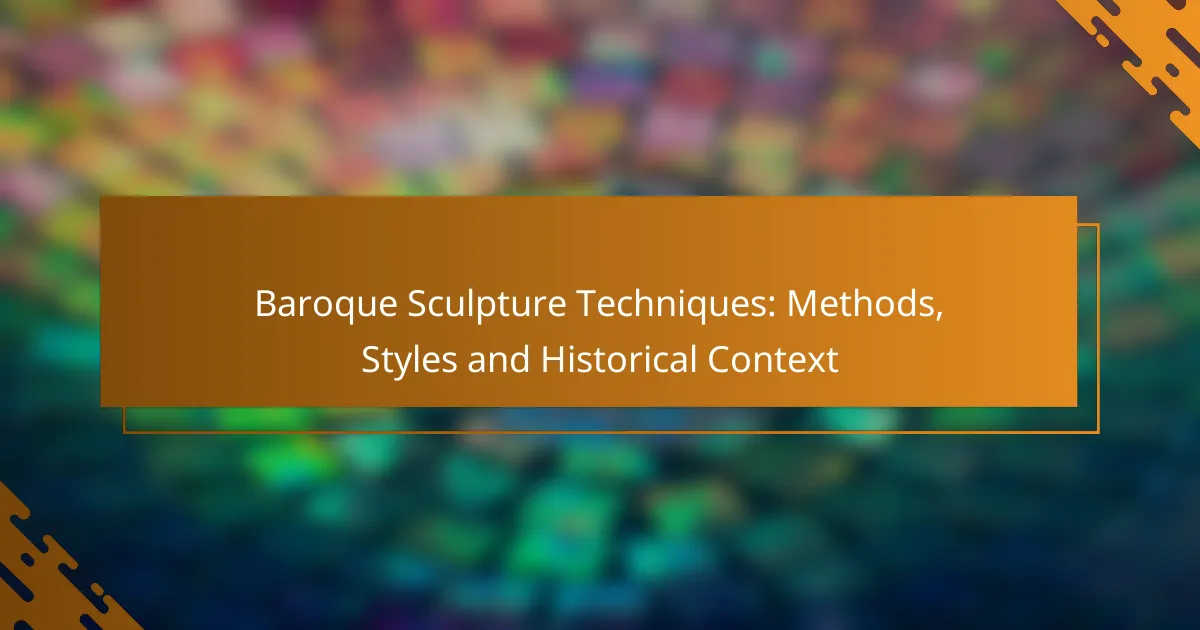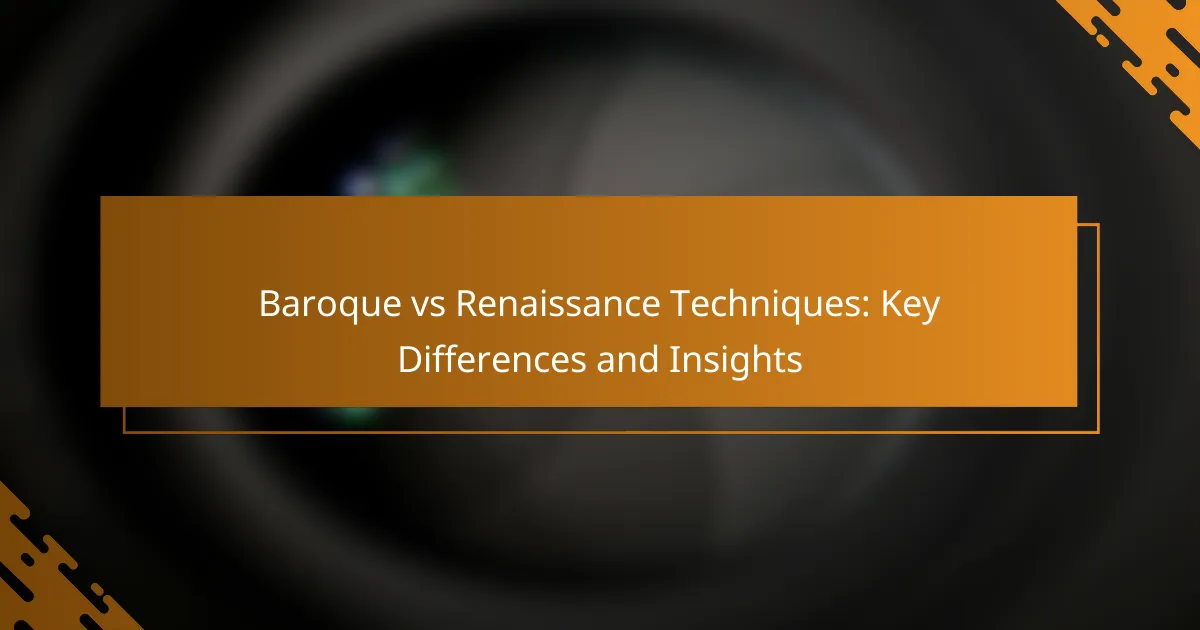Chiaroscuro, a hallmark of Baroque paintings, is characterized by the striking contrasts between light and shadow that create a sense of depth and volume. Recognizing this technique is crucial for collectors, as it enhances the emotional intensity of the artwork and directs the viewer’s attention. Mastery of chiaroscuro is evident in the works of renowned artists like Caravaggio and Rembrandt, who skillfully employed this dramatic approach to elevate their compositions.
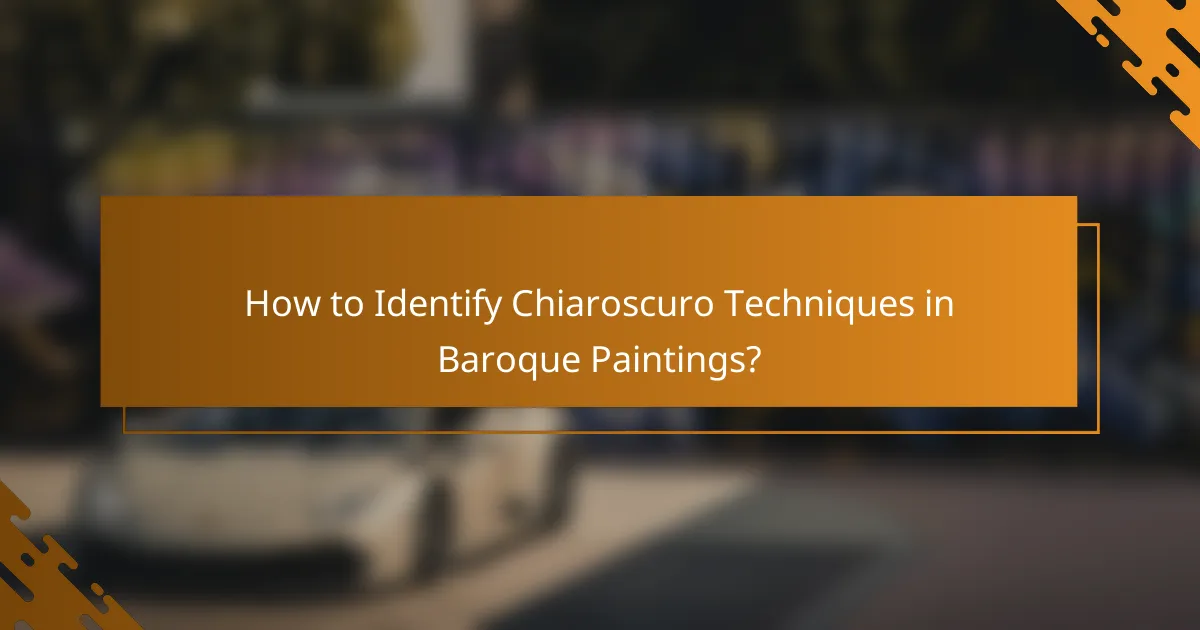
How to Identify Chiaroscuro Techniques in Baroque Paintings?
To identify chiaroscuro techniques in Baroque paintings, focus on the dramatic contrasts between light and shadow that create depth and volume. This technique enhances the emotional impact of the artwork, making it essential for collectors to recognize key elements that define this style.
Examine light and shadow contrasts
Chiaroscuro is characterized by stark contrasts between light and dark areas. Look for areas where light dramatically illuminates subjects while deep shadows envelop others, creating a three-dimensional effect. This interplay often directs the viewer’s attention to focal points within the composition.
When assessing a painting, consider how the artist uses light to highlight figures or objects against darker backgrounds. Notable examples include Caravaggio’s works, where the use of light often conveys intense emotion and drama.
Analyze color palettes used
The color palette in chiaroscuro paintings typically features a limited range of hues, often dominated by dark tones with occasional bright highlights. This selective use of color enhances the contrast between light and shadow, reinforcing the three-dimensionality of the subjects.
Pay attention to how warm and cool colors are employed. Warm colors may be used in illuminated areas, while cooler tones often dominate shadowed regions. This technique can create a sense of atmosphere and mood, further enhancing the painting’s emotional resonance.
Study brushwork and texture
Brushwork in chiaroscuro paintings can vary significantly, but it often features bold, sweeping strokes that contribute to the overall dynamism of the piece. Look for textures that suggest depth, particularly in shadowed areas where the paint may be applied more thickly.
Examine the details in highlighted areas, where finer brushwork may be used to create realistic textures, such as skin or fabric. This contrast in technique between light and dark areas can reveal the artist’s mastery of chiaroscuro and their intention to evoke specific feelings in the viewer.

What are the key characteristics of Baroque Chiaroscuro?
Baroque chiaroscuro is defined by its dramatic use of light and shadow to create depth and volume in paintings. This technique enhances emotional intensity and guides the viewer’s focus, making it a hallmark of the Baroque art movement.
Strong contrasts between light and dark
One of the most striking features of Baroque chiaroscuro is the strong contrasts between light and dark areas in a painting. Artists like Caravaggio utilized this technique to create a sense of drama and highlight specific subjects within the composition. When examining a piece, look for sharp transitions that draw the eye to the focal points.
Collectors should note that these contrasts can vary significantly, with some works exhibiting subtle gradations while others present stark differences. Understanding the artist’s intent behind these contrasts can enhance appreciation and valuation.
Emphasis on three-dimensionality
Baroque chiaroscuro emphasizes three-dimensionality by using light and shadow to model forms realistically. This technique gives figures a sculptural quality, making them appear more lifelike and engaging. When assessing a painting, observe how the interplay of light creates volume and spatial relationships among the elements.
To identify this characteristic, look for rounded forms and shadows that suggest depth. Effective use of chiaroscuro can make flat surfaces seem to recede or project forward, enhancing the overall impact of the artwork.
Dynamic compositions and movement
Dynamic compositions and movement are essential aspects of Baroque chiaroscuro, often achieved through the strategic placement of light and shadow. Artists created a sense of action and energy, guiding the viewer’s eye through the painting. When evaluating a piece, consider how the arrangement of light influences the perceived motion within the scene.
Collectors should be aware that effective use of chiaroscuro can lead to a more compelling narrative within the artwork. Look for swirling drapery, gesturing figures, and other elements that suggest movement, as these contribute to the overall dynamism characteristic of the Baroque style.
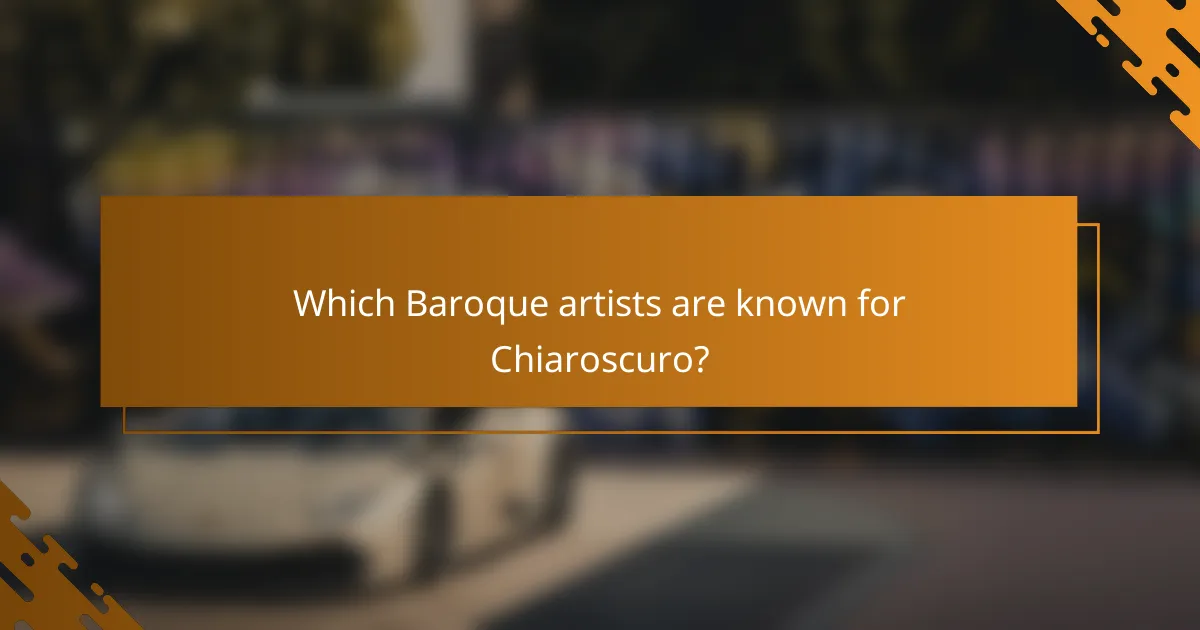
Which Baroque artists are known for Chiaroscuro?
Several Baroque artists are renowned for their mastery of chiaroscuro, a technique that emphasizes the contrast between light and dark to create depth and volume. Notable figures include Caravaggio, Rembrandt, and Gian Lorenzo Bernini, each contributing uniquely to this dramatic style.
Caravaggio
Caravaggio is often credited with pioneering the chiaroscuro technique in painting. His works, such as “The Calling of Saint Matthew,” showcase stark contrasts that draw the viewer’s eye to key elements, enhancing the narrative tension. Collectors should look for deep shadows and bright highlights that create a three-dimensional effect.
When assessing a Caravaggio piece, pay attention to the use of natural light and how it interacts with the figures. His dramatic compositions often feature a single light source, which adds to the emotional intensity of the scene.
Rembrandt
Rembrandt’s approach to chiaroscuro is characterized by a more subtle and nuanced use of light. His paintings, like “The Night Watch,” demonstrate a sophisticated interplay of light and shadow that adds complexity to the characters and settings. Collectors should note the warm tones and soft transitions between light and dark.
In evaluating Rembrandt’s work, focus on the layering of paint and the texture created through his brushwork. His ability to capture the human condition through light makes his pieces particularly valuable and sought after.
Gian Lorenzo Bernini
While primarily known as a sculptor, Gian Lorenzo Bernini also employed chiaroscuro in his architectural and sculptural works. His sculptures, such as “The Ecstasy of Saint Teresa,” utilize light and shadow to enhance emotional expression and movement. Collectors should consider how the play of light affects the perception of form and detail in his pieces.
When examining Bernini’s work, look for the dynamic contrasts that highlight the intricacies of his sculptures. The way light interacts with the materials can significantly influence the overall impact of the artwork, making it essential for collectors to appreciate this aspect.

What tools can collectors use for identification?
Collectors can utilize various tools to identify chiaroscuro techniques in Baroque paintings. Key instruments include UV light, magnifying glasses, and specialized art authentication software, each serving distinct purposes in examining the artwork’s layers, brushwork, and overall authenticity.
UV light for examining layers
UV light is essential for revealing underlying layers in Baroque paintings. When illuminated with UV light, certain pigments fluoresce, allowing collectors to see previous paint applications, repairs, or alterations that are not visible under normal lighting.
Using a handheld UV light, collectors can scan the surface of the painting. Look for inconsistencies in fluorescence, which may indicate restoration work or the use of modern materials. This technique is particularly useful for assessing the integrity of chiaroscuro effects, as these can be altered during restoration.
Magnifying glass for brushstroke analysis
A magnifying glass is a practical tool for analyzing brushstrokes in detail. By examining the texture and layering of paint, collectors can identify the artist’s technique and verify the authenticity of the work. Different artists have unique brushstroke styles that can be discerned with careful observation.
When using a magnifying glass, focus on areas where light and shadow interact. Look for variations in paint thickness and direction, which can indicate the use of chiaroscuro. Keep in mind that excessive wear or damage may obscure these details, so consider the overall condition of the painting when making assessments.
Art authentication software
Art authentication software leverages technology to analyze artworks for authenticity and attribution. These programs can assess various factors, including color composition, brushwork patterns, and even historical data related to the artist’s known techniques.
Many software solutions offer features like image comparison and database searches, which can help collectors identify potential forgeries. However, while these tools can provide valuable insights, they should complement, not replace, traditional methods of examination. Always cross-reference findings with expert opinions when possible.

How does provenance affect Chiaroscuro paintings?
Provenance significantly impacts Chiaroscuro paintings by providing a documented history of ownership that can confirm authenticity and enhance value. Collectors should consider the provenance as a critical factor when assessing the quality and investment potential of a piece.
Establishes authenticity
Provenance helps establish the authenticity of Chiaroscuro paintings by tracing their history back to the original artist or recognized galleries. A well-documented provenance can include exhibition records, previous sales, and expert appraisals, which collectively support the painting’s legitimacy.
For instance, if a painting can be linked to a reputable auction house or a known collector, it strengthens claims of authenticity. Conversely, a lack of provenance may raise doubts about the work’s origins, making it less desirable.
Increases market value
A strong provenance can significantly increase the market value of Chiaroscuro paintings. Artworks with clear, documented histories often command higher prices due to their perceived reliability and desirability among collectors.
For example, a painting with a well-established provenance might sell for tens of thousands of dollars more than a similar piece without documentation. Collectors should prioritize acquiring works with solid provenance to maximize their investment potential.
